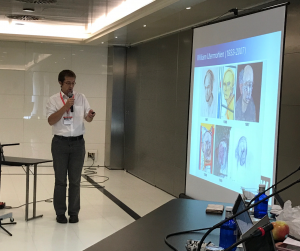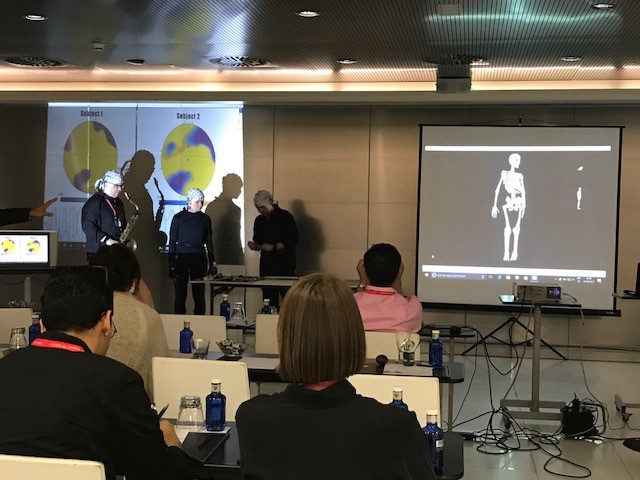By Juliet L. King MA, ATR-BC, LPC, LMHC | September 28, 2017 | Events | Research
I am so grateful to have had the opportunity to attend the second annual International Conference on Mobile Brain-Body Imaging and the Neuroscience of Art, Innovation and Creativity in Valencia, Spain, September, 10-13. As in last year’s Brain on Art conference, modern thinkers from around the world participated in thoughtful didactic and experiential dialogue. They explored the intersection of arts and sciences and the use of neuroimaging technology and Brain-Computer Interfaces (BCI) that seek to capture and understand brain functioning during real-time activities and interactions with the environment.
The conference was organized into four tracks: 1) Wearable technologies, 2) Neuroaesthetics and the Biology of Creativity, 3) Medical and Pedagogical Applications, and 4) Artistic Brain-Computer Interfaces. The individual presentations were 12-15 minutes in length and were followed with an open forum led by a moderator responsible for an interactive Q&A. Topics covered were multi-dimensional and included questions such as,

Sebastian Crutch presents: “Creating out of Mind: Shaping perceptions of dementia through art and science”
- How do the creative arts engage the human mind and promote creativity and innovation across fields?
- How do arts-sciences collaborations create new knowledge through aesthetic problem solving?
- How do we understand brain mechanisms of aesthetic perception and what is the value of artistic brain-computer interfaces?How is neurotechnology changing science, arts and innovation?
- How can the arts and neurosciences describe and promote the processes of learning and creativity in K-12 and higher education?
- How can arts and neuroscience research improve physical and mental healthandpromote wellbeing?
The clinical implications of merging arts and neurosciences was substantial this year. The value of the creative arts therapies to inform scientific research was recognized as we continue to learn more about the technological advances that will generate evidence to further support our interventions.
I had the distinct honor to moderate a panel that included art therapy researcher Girija Kaimal, EdD, MA, Assistant Professor in Drexel University’s PhD program in Creative Arts Therapies, and art therapist Melissa Walker, ATR, most known for her meaningful work with active duty service members at the National Intrepid Center of Excellence (NICoE) at Walter Reed in the National Capital Region. Panel members alsoincluded Dance-Movement therapist Rainbow Ho, PhD, BC-DMT, AThR, from the University of Hong Kong, China and neuropsychologist Sebastian Crutch from the UCL Institute of Neurology, United Kingdom, whose clinical work and research with dementia uses both art and science to focus on how perception is shaped. Crutch is likely most known for his work with William “Bill” Utermohlen, whose self-portraits, distributed world-wide have likely become the most visible and compelling example of the devastation of Alzheimer’s disease and, as Crutch remarked, is “much more powerful than any data set.”

Art therapists in discussion. From left: Melissa Walker, ATR; Girija Kaimal, EdD, MA; and Juliet King, MA, ATR-BC, LPC, LMHC.
Rainbow Ho presented on an expansive range of her work as a clinician and a researcher. She shared visual imagery and patient vignettes of those managing depression, survivors of sexual abuse, earthquake survivors, and people diagnosed with developmental disabilities. Dr. Ho highlighted her work in the medical educational settings and described how the philosophies of creative arts therapies help facilitate empathy in contemporary medical care.
Melissa Walker’s presentation focused on the realities of the clinical management of psychological and physical trauma and the importance of integrating an understanding of brain science in our assessment and practice. Walker is strongly invested in further researching the neuronal mechanisms involved in the therapeutic relationship. She asks important questions such as, “What is happening during therapy, and how do we study it?” Bill O’Brien, Senior Advisor for Innovation to the Chairman for the National Endowment of the Arts (NEA), Melissa’s colleague, and friend of art therapy, complemented this presentation later in the program when he highlighted the Creative Forces: NEA Military Healing Arts Network.
Professor Kaimal, also a recipient of NEA funding, discussed her prolific research utilizing physiological data and biomarkers such as cortisol to measure the impact of studio arts versus coloring books on levels of stress and affect. She spoke to the use of Functional Near-Infrared Spectroscopy (fNIRS) as an emerging and accessible tool that can test the efficacy of art therapy interventions compared to alternative treatments and non-clinical applications such as meditation and yoga.
Dialogue following the individual presentations, on what came to be affectionately known as the “Therapy Panel,” focused on topics including the importance of non-verbal therapies in the treatment of trauma, the role of memory as engaged by art making, and the power of the arts as a mechanism for healing. An important question, posed to the panel by Norberto Grzywacz, Dean and Professor of the Graduate School of Arts and Sciences at Georgetown University, led to a lengthy discussion about the continuum of therapeutic arts and art therapy. It is necessary to distinguish between arts-based interventions that in their own right are healing and the clinical interventions of the creative arts therapies. The creative arts therapies are founded in specific psychotherapeutic processes that require a masters-level training to understand and apply. The panel discussed the ethical obligations that accompany the work of the psychotherapist, the intrapsychic change that is considered throughout treatment, and how the specific goals of psychotherapy are essential when making distinctions between therapeutic arts and creative arts therapy interventions. These crucial distinctions help us connect with and support the therapeutic arts while at the same time maintaining the integrity of our work as clinical practitioners.

Exquisite corpse.
This conference, heavily influenced by the capacities of neuroengineering and its outcomes, included the arts as important players on equal grounds with the more empirically-based measures that define science. In a dynamic experiential presentation, the conference organizer Pepe Contreras-Vidal fitted his team of neural engineers that included a dancer, musician, and conceptual artist with skullcaps embedded with surface electrodes that listened to their brainwave activity while they played a creative variant of Exquisite Corpse, based on the game made famous by the Surrealists. The audience had the opportunity to view the brain processes that accompanied the myriad creative acts and interactions in real time.
The value of creativity and the deepening of understanding shared by artists and scientists was a recurring theme. Laurie Baefsky, PhD, Executive Director of the Alliance for the Arts in Research Universities (a2ru), an organization committed to advancing arts-integrative research, curricula, and programs in research universities, spoke on the importance of fostering interdisciplinary collaborations in academic institutions. Sha Xin Wei, PhD, Professor and Director of the School of Arts, Media and Engineering and the Synthesis Center at Arizona State University, discussed how ways of being, as an artist and as a human, are given meaning through the response evoked by art. Throughout the conference, Doctoral and Post-Doctoral fellows participated and competed in a three-day “hackathon,” during which they teamed up and created new inventions using Brain-Computer interfaces (BCI).
The creative arts therapies have the capacity to generate knowledge from multidimensional scientific perspectives that will contribute to the understanding and application of contemporary healthcare practices. There are many ways of knowing. The continuum known as hard, to soft, to pseudosciences can and should be replaced with “what we know more about,” and “what we know less about” in terms of how far we have come in research. Creativity allows us to traverse this continuum, and symbolic expression provides us a context to understand and identify with an array of scientific methodologies. This conference was a beautiful invitation to embrace the frontiers of knowing, and we can look forward to further discussions at the next conference in Berlin, Germany, in July, 2018.
